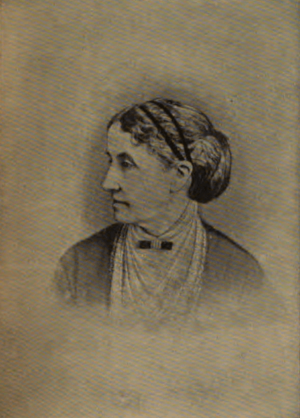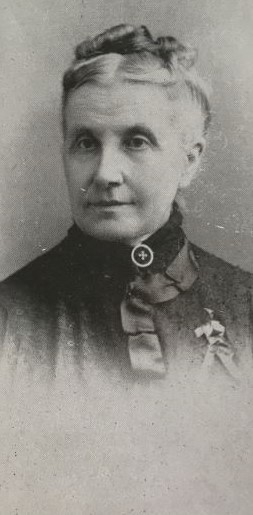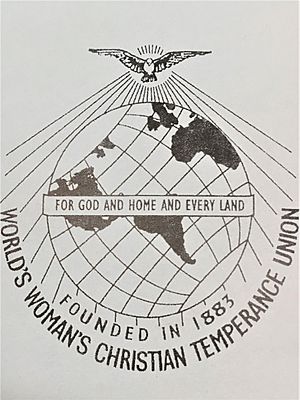Mary Greenleaf Clement Leavitt facts for kids
Quick facts for kids
Mary Greenleaf Clement Leavitt
|
|
|---|---|

Mary Clement Leavitt (1887)
|
|
| Born | September 22, 1830 Hopkinton, New Hampshire, US
|
| Died | February 5, 1912 (aged 81) Boston, Massachusetts, US
|
| Occupation | Educator, suffragist, women's rights activist, Temperance Evangelist Missionary |
| Spouse(s) | Thomas Hooker Leavitt, m. June 3, 1857, divorced 1878 |
| Signature | |
Mary Greenleaf Clement Leavitt (September 22, 1830 – February 5, 1912) was an amazing teacher and speaker. She became the very first worldwide missionary for the Woman's Christian Temperance Union (WCTU). For over ten years, she traveled almost constantly around the world. She visited nearly every continent, fighting against family violence and supporting women's suffrage (the right for women to vote). She also pushed for other equal rights, like better education for girls and women. In 1891, she was made the honorary president for life of the World's WCTU.
Contents
Mary Leavitt's Early Life
Mary Greenleaf Clement was born on September 22, 1830, in Hopkinton, New Hampshire. Her father, Rev. Joshua Clement, was a Baptist minister, and her mother was Eliza (Harvey) Clement. Her parents were against slavery. Mary was the second of nine children. She went to school at Thetford Academy and then at the Massachusetts State Normal School. She graduated in 1851 as the top student. After that, she taught in Dover, Massachusetts, and then in Boston for several years.
Becoming an Educator and Activist
Mary married Thomas Hooker Leavitt in Boston on June 3, 1857. They had three daughters. Mary Leavitt later opened her own private school in Boston, which she ran from 1867 to 1881. Her school was quite large, with many students and teachers. Mary herself taught French, Latin, and singing.
Joining the Temperance Movement
Mary grew up in a religious family that cared about social issues. She became interested in the temperance movement, which aimed to reduce or stop the use of alcohol. The Woman's Christian Temperance Union (WCTU) started in 1873. Women in Ohio and New York were worried about how alcohol affected families. They began to meet, pray, and protest at places that sold alcohol. These women, like Mrs. Esther McNeil and Mrs. Eliza Thompson, became famous for their efforts.
The temperance movement gave women a chance to speak out and make a difference, especially since most women couldn't vote yet. WCTU leaders, like Frances Willard, also supported women's suffrage. They believed that if women could vote, they could better protect their homes and families. Under Willard's leadership, the WCTU became the biggest women's group in the country.
Mary Leavitt was one of the first activists in this movement. She met Frances Willard in 1877. Willard described Mary as a smart, strong, and calm woman. Mary then started the first WCTU group in Boston and was its president from 1879 to 1880.
Working for the WCTU Full-Time
In 1881, Mary Leavitt closed her school to work full-time for the WCTU. She wanted to promote temperance and women's right to vote. She became the first leader of the National WCTU's department for voting rights in 1882. As she traveled through New England, she also spoke for the New England Women's Suffrage Association. Her daughter Edith even sang at one of their big meetings. Mary gave powerful speeches about women's rights and how men's views on women could change.
After her father passed away in 1883, Frances Willard asked Mary to travel to the Mississippi Valley and the West Coast. In July 1883, Mary went to California, Oregon, and Washington to start new WCTU groups there. From 1883 to 1891, she worked as a secretary for the WCTU.
Frances Willard saw Mary Leavitt's great organizing skills and her popularity as a speaker. Willard asked her to go on a special mission to the Far East to see how the WCTU could help with temperance efforts around the world. Mary was called the WCTU's "Superintendent of Reconnaissance for World's WCTU." Her first trip abroad was meant to visit Hawaii and the Far East to introduce WCTU ideas and build connections.
Becoming a World Missionary
Mary Leavitt's journey began with a challenge. She left America with only $35 of her own money and no financial help from the national WCTU. Frances Willard wrote in the WCTU's newspaper, The Union Signal, that Mary "has no capital save her faith." Willard asked her followers to pray for Mary and her important mission.
However, many people around the world were ready to hear Mary's message. Temperance activists found people eager to listen in places like New Zealand and Australia. In 1885, Mary helped start the New Zealand Woman's Christian Temperance Union. Many women who supported voting rights, like Kate Sheppard, became leaders in this new organization.
The Polyglot Petition
In August 1885, Frances Willard sent Mary the Polyglot Petition. This was a huge petition meant to gather signatures from people all over the world. It asked world leaders to take a stand against alcohol and the opium trade. Willard started this petition, and it eventually collected nearly 7.5 million signatures!
The Polyglot Petition, with signatures from people on six continents, was pasted onto almost 100 rolls of canvas. Today, it is kept at the Frances Willard Historical House and Museum in Evanston, Illinois, USA.
Travels to Hawaii and Beyond
On November 15, 1884, Mary Leavitt sailed from San Francisco to Honolulu (Hawaiian Islands). She had only $35 and a letter of introduction from her minister. She worked with Mrs. J.M. Whitney in Honolulu to find places to speak. Mary traveled to several Hawaiian towns, using interpreters to speak to different groups of people, including native Hawaiians, Portuguese, Japanese, and Chinese. Everyone welcomed her. On November 22, 1884, Mary helped start the Honolulu WCTU with forty women. They even gave her about $400 to help her continue her travels.
Mary then traveled from Honolulu to Australia, stopping in Auckland, New Zealand. She arrived on January 14, 1885. She began giving talks in Auckland on January 27. By February 4, 1885, she led the meeting that founded the Auckland WCTU. For the next seven months, she visited many cities and towns across New Zealand's islands. In Wellington, she met Anne Ward (suffragist), who took over leading the national organization after Mary left.
By mid-August 1885, Mary arrived in Sydney, Australia. She traveled widely across Australia, including Tasmania. She started five WCTU groups in Queensland, one in New South Wales, one in South Australia, and three in Tasmania.
Journeys to Asia
Mary needed more money to continue her world tour. Frances Willard was able to promise her $3,700. Mary sailed from Sydney to Japan in April 1886, planning to use these funds to travel through Asia and then to Africa.
Mary arrived in Yokohama, Japan, on June 1, 1886. She quickly found people to help her arrange lectures. For five months, she spoke in many Japanese cities. She also wrote articles about the scientific reasons for temperance, which were translated into Japanese. Many of her connections came from Christian Japanese men from former samurai families. Several local temperance groups were formed.
Mary visited Chelmulpo, Korea, on October 16, 1886, and then continued to China. From October 1886 to February 1887, she gave talks in many Chinese cities like Shanghai and Canton.
After China, Mary went to South Asia. She arrived in Bangkok, Thailand, on February 2, 1887, and spent a month there. Then she moved on to Singapore and Myanmar (Burma), where she spent four months giving speeches.
By July 23, 1887, Mary Leavitt reached Calcutta in India. Her tour of India lasted almost a year, with lectures in many cities. She then spent nearly three months in Sri Lanka (Ceylon). Mary faced some challenges with British people living there who didn't like women speaking in public. However, she successfully formed many WCTU groups, including those with members "of all religions." She left Mrs. M.D. MacDonald in charge of the WCTU there. Mary also kept in touch with sisters Margaret and Mary Leitch, who collected 33,000 signatures for the Polyglot Petition. The World Woman's Christian Temperance Union (WWCTU) supported Pandita Ramabai, who opened a school for young Hindu widows in Mumbai.
Visiting Africa and Other Countries
Mary left India and arrived in Mauritius on September 10, 1888. She spent two weeks there before traveling to Madagascar. She lectured in several cities until December 12, 1888. The Queen of Madagascar admired Mary and even gave money for her travel. Mary wrote back to her contacts about the terrible effects of alcohol on the people of Madagascar. From there, she traveled south to South Africa, arriving in Durban on December 14, 1888. For several weeks, she spoke in many towns.
Mary traveled from Africa to England, where she was welcomed by the British Women's Temperance Association on September 23, 1889. She also spoke in Greenock, Scotland, to a large audience. She attended a purity congress in Geneva, Switzerland, and then returned to England. In 1890, she sailed to Sierra Leone and Madeira before returning to Europe. She spoke in Spain, France, Belgium, Germany, Denmark, and Finland. In early 1891, she traveled across the Mediterranean and spoke many times in Cairo, Egypt. She then visited Turkey, Israel, and Syria. At each stop, Mary organized more WCTU groups and other societies to protect women and children.
Mary Leavitt sailed from England on June 6, 1891, and arrived home in Boston on June 18. She had spent only about $8,000, with much of it collected during her speeches. It had been eight years since she left Boston! In January 1892, Mary traveled to South America, visiting Argentina, Uruguay, and Brazil. She was often sick with yellow fever. She faced some challenges, like college men throwing stones at her in Brazil. Despite this, she traveled nearly 14,000 miles and held 82 meetings. In later winters, she visited Mexico (1895), Bahamas (1896), and Jamaica (1897).
By the end of her ten years of travels, Mary Leavitt had started over 86 WCTU groups and 21 men's temperance societies in more than 40 countries. Her success inspired other WCTU missionaries, like Jessie Ackermann, to begin their own world tours.
The Impact of Her Mission
Mary Leavitt's mission was even more successful than the WCTU leaders had hoped. Frances Willard created the "Leavitt Fund" to help pay for Mary's travels and work. However, because the groups Mary started often became self-supporting, and she covered her own costs through donations, the fund was later used to support other WCTU missionaries.
As the worldwide temperance movement grew, activists like Mary Leavitt, who had helped start WCTU groups in India, found themselves involved in other important causes. For example, Mary and others began to question why Britain still ruled India. Indian reformers, who joined the temperance movement, also shared their ideas for change. Pandita Ramabai, a leading female activist in India, worked with the WCTU to fight for the rights of widows and child brides.
Mary Leavitt's message was not always easy to share. Sometimes, her ideas about temperance, voting rights, and women's rights were difficult for different cultures to accept. For example, in Bangkok, she met with King Chulalongkorn at his palace. The King made a large donation to a home for elderly women, which Mary appreciated.
Midway through Mary's travels, the WCTU estimated that she had traveled over 100,000 miles in 43 different countries. She had crossed the Equator eight times, held over 1,600 meetings, and used 290 different interpreters speaking 47 languages. She formed 130 temperance societies, including 86 WCTU groups and 23 branches of the White Cross Society, which aimed to protect women and children. She also started "Bands of Hope" for children.
World WCTU Conventions
Mary Leavitt brought copies of the Polyglot Petition to show at the first World WCTU Convention in Boston, Massachusetts, in November 1891. She presented a plan for the countries she had visited, and it was accepted. Mary was elected WWCTU secretary but declined due to her health. She was then chosen as the Honorary President of the WWCTU.
The second World WCTU Convention was held in Chicago in 1893, at the same time as the World Fair. Mary could not attend, but she was again named Honorary President. Her birthday was even named WWCTU Day.
Supporting the Anti-Lynching Movement
In 1899, Mary Leavitt was one of the speakers at a women's anti-lynching event in Boston. She spoke alongside other important figures like Julia Ward Howe and Alice Freeman Palmer. This showed her commitment to fighting for justice for all people.
Recognition for Her Service
Mary Leavitt was eventually named the Honorary Life President of the WCTU, a title she held for 20 years. She often spoke at the national conventions. Lillian M.N. Stevens, the National President, praised Mary in 1912, calling her a woman of "heroic courage and great achievement." She noted Mary's strong faith and how she traveled for eight years in 43 different countries, often without seeing anyone she knew. Stevens said that Mary's "splendid pioneer work" would always be remembered.
Mary Leavitt's Passing
Mary Greenleaf Clement Leavitt passed away at her home in Boston on February 5, 1912. Her daughter Amy, who went to Mary's private school, later became a translator and musician. Another daughter, Agnes, managed an art studio where she sold her paintings and taught art.
See also



